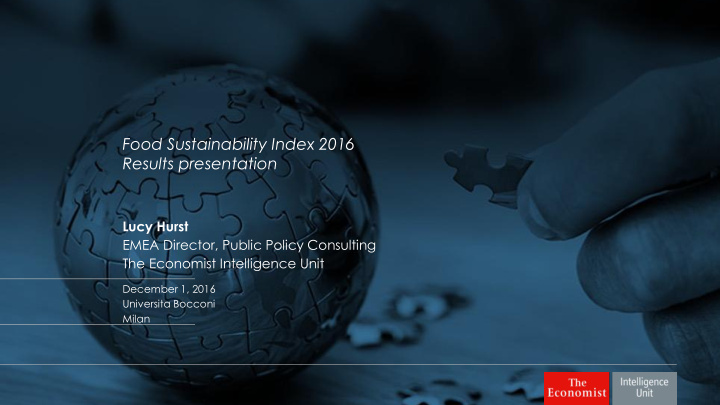



Food Sustainability Index 2016 Results presentation Lucy Hurst EMEA Director, Public Policy Consulting The Economist Intelligence Unit December 1, 2016 Universita Bocconi Milan
The Food Sustainability Index Overview The Food Sustainability Index (FSI), ranks 25 countries according to their food system sustainability Three pillars, identified by the Milan Protocol and linked to the SDGs: Nutrition, Sustainable Agriculture practices and Food Loss and Waste . 58 specific measures with three sustainability KPIs : societal, environmental and economic The index framework , key definitions and structures were developed by the EIU in consultation with the BCFN advisory board. The 25 countries : G20 plus regional representation (Colombia, Egypt, Ethiopia, Israel, Nigeria, and the UAE) Sustainability – the food system is maintained without depletion and exhaustion of its natural resources or A City Monitor for 16 cities compromises to its health and integrity, and without Looks at urban food systems compromising future generations’ access to food . . 2
What have we learned? Key findings and best practices across the 3 areas of assessment Food loss and food waste ▪ Food loss and waste are front and centre in policy agendas , and food retailers in particular have strengthened efforts ▪ Food loss in emerging markets could be improved via better transport infrastructures, storage and market information. Sustainable agriculture ▪ Cultivable arable land is running out and countries must make choices between land for human food crops vs non-food crops such as biofuels. A range of solutions are in order. ▪ The right policies and measures are critical in developing countries institutional and infrastructure reforms help strengthen agricultural efficiency. These include more transparent land rights , access to finance for farmers , better storage and transportation networks. Nutritional challenges ▪ Developing countries are experiencing “premature” obesity rates. Rates are increasing in low and middle income countries, especially among children, while fighting hunger continues. ▪ Micronutrient deficiencies are still prevalent in many developing countries. Despite progress with combatting hunger, dietary quality and diversity are still unmet goals . 3
Evaluative framework
Pillar 1: Food Loss & Waste Food loss ▪ Food lost as % of total food production of the country ▪ Policy response to food loss ▪ Causes of distribution-level loss (quality of the road infrastructure) ▪ Solutions to distribution-level loss (investment in transport infrastructure) End-user waste ▪ Food waste per capita per year ▪ Policy response to food waste
Pillar 2: Sustainable agriculture Water Environmental impact of agriculture on water (water footprint) ▪ Sustainability of water withdrawal (agricultural water withdrawal as % of ▪ total renewable water resources) Water scarcity (monthly freshwater scarcity) ▪ Water management (initiatives to recycle water for agricultural use) ▪ Land (land use, biodiversity, human capital) Environmental impact of agriculture on land (input use, soil lost to ▪ desertification/pollution, carbon content) Land use (% organic agriculture, % of utilised agricultural area, sustainable ▪ urban farming initiatives) Impact on land of animal feed and biofuels ▪ Land ownership quality ▪ Agricultural subsidies ▪ Quality of animal welfare regulation ▪ Diversification of agricultural system (share of top 3 crops of total ▪ agriculture production) Environmental biodiversity measured by the GEF benefits index for ▪ biodiversity Quality of R&D and innovation ▪ Productivity ▪ Land-users (% women and youth in farming, average age of farmers) ▪ Air (GHG emissions) Environmental impact of agriculture on the atmosphere (GHG emissions ▪ from agriculture) Climate change mitigation initiatives ▪
Pillar 3: Nutritional challenges Life quality ▪ Prevalence of undernourishment ▪ Prevalence of stunting, wasting and underweight in children ▪ Micronutrient deficiency (Vitamin A, iodine) ▪ Ecological efficiency of supporting people’s well being Life expectancy ▪ Healthy life expectancy ▪ Prevalence of over nourishment ▪ Deficient diet impact on health ▪ Physical activity levels Diets ▪ Prevalence of sugar in diets ▪ Number of people per fast food restaurants ▪ Purchasing power for fresh food ▪ Policy response to dietary patterns
Top performers overall and across the 3 pillars
Top 3 and bottom 3: Overall and Across the 3 pillars Snapshot or results – No perfect scores, biggest range in food loss and waste Top performers overall Food loss and food waste Sustainable agriculture Nutritional challenges Top 3 Top 3 Top 3 Top 3 France 67.53 France 80.25 Germany 65.50 France 72.05 Japan 66.66 Australia 76.30 Canada 62.35 Japan 70.27 Canada 64.86 S Africa 75.70 Japan 60.56 S Korea 69.60 Bottom 3 Bottom 3 Bottom 3 Bottom 3 Egypt 48.85 UAE 32.55 Egypt 44.83 S Africa 53.22 Saudi Arabia Indonesia UAE 41.39 Nigeria 52.91 47.43 32.53 India 40.51 India 45.04 India 43.17 Saudi Arabia 27.56 9
The City Monitor Pilot study to consider city-level food sustainability ➢ 16 Cities worldwide based on geographic representation and data availability and urban food policy response and implementation ➢ Metrics assess the existence of sustainable urban farming initiatives and enabling policies , obesity rates , availability of green spaces among others London Mexico City Milan Berlin Paris Moscow Toronto Tel Aviv Belo Horizonte Dubai Johannesburg San Francisco Shanghai Lagos Kyoto Mumbai 10
Thank you Lucy Hurst EMEA Director, Public Policy Consulting The Economist Intelligence Unit lucyhurst@eiu.com Adam Green Senior Editor The Economist Intelligence Unit adamgreen@economist.com
Recommend
More recommend